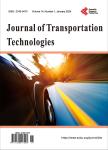Demand Elasticity of Capacity Offered for Urban Rail Transport
Demand Elasticity of Capacity Offered for Urban Rail Transport作者机构:Transport Planning School of Planning & Architecture New Delhi India Traffic Department Northern Railways New Delhi India
出 版 物:《Journal of Transportation Technologies》 (交通科技期刊(英文))
年 卷 期:2016年第6卷第4期
页 面:163-168页
学科分类:0202[经济学-应用经济学] 02[经济学] 020205[经济学-产业经济学]
主 题:Congestion Demand Elasticity Supply Urban Rail Transport
摘 要:The high peak hour demand in Urban Rail Transport (URT) is usually met by supply side measures such as pushing more number of trains/cars in peak hour by the operator. This additional capacity generates more demand due to a positive elasticity of demand with respect to services. Delhi Metro Rail Corporation (DMRC), India has converted its fleet from 4 cars per train to 6 cars per train and finally to 8 cars per train on its Broad Gauge section. The ridership of the system has also witnessed double digit growth during this conversion period. The demand elasticity w.r.t services for the passengers of DMRC has been estimated as 0.512 on the basis of growth of demand and increase in capacity after adjusting for natural growth. So a 10% increase in supply results into 5% increase in capacity. A simple service elasticity model has been developed to estimate demand with increase in supply. The model has been applied to Line 2 (yellow line), the busiest line of DMRC, to estimate the demand for different level of services (trains/hour). The efficacy of supply side measures is limited by the design capacity of the system beyond which any increase in supply would require disproportionate investment. An optimum combination of supply and demand side measures would perhaps be the best way to address peak hour congestion in Urban Rail Transport.



